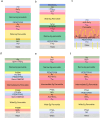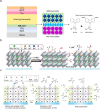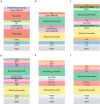All-perovskite tandem solar cells: from fundamentals to technological progress
- PMID: 38962674
- PMCID: PMC11218037
- DOI: 10.1039/d3ee03638c
All-perovskite tandem solar cells: from fundamentals to technological progress
Abstract
Organic-inorganic perovskite materials have gradually progressed from single-junction solar cells to tandem (double) or even multi-junction (triple-junction) solar cells as all-perovskite tandem solar cells (APTSCs). Perovskites have numerous advantages: (1) tunable optical bandgaps, (2) low-cost, e.g. via solution-processing, inexpensive precursors, and compatibility with many thin-film processing technologies, (3) scalability and lightweight, and (4) eco-friendliness related to low CO2 emission. However, APTSCs face challenges regarding stability caused by Sn2+ oxidation in narrow bandgap perovskites, low performance due to V oc deficit in the wide bandgap range, non-standardisation of charge recombination layers, and challenging thin-film deposition as each layer must be nearly perfectly homogenous. Here, we discuss the fundamentals of APTSCs and technological progress in constructing each layer of the all-perovskite stacks. Furthermore, the theoretical power conversion efficiency (PCE) limitation of APTSCs is discussed using simulations.
This journal is © The Royal Society of Chemistry.
Conflict of interest statement
There are no conflicts to declare.
Figures













Similar articles
-
Methylammonium-free, high-efficiency, and stable all-perovskite tandem solar cells enabled by multifunctional rubidium acetate.Nat Commun. 2025 Jan 30;16(1):1164. doi: 10.1038/s41467-025-56549-8. Nat Commun. 2025. PMID: 39885155 Free PMC article.
-
Recent Progress on High-Efficiency Perovskite/Organic Tandem Solar Cells.Nanomaterials (Basel). 2025 May 15;15(10):745. doi: 10.3390/nano15100745. Nanomaterials (Basel). 2025. PMID: 40423135 Free PMC article. Review.
-
Highly Efficient Perovskite-Perovskite Tandem Solar Cells Reaching 80% of the Theoretical Limit in Photovoltage.Adv Mater. 2017 Sep;29(34). doi: 10.1002/adma.201702140. Epub 2017 Jul 10. Adv Mater. 2017. PMID: 28692764
-
Progress and outlook of Sn-Pb mixed perovskite solar cells.Nano Converg. 2023 Jun 16;10(1):27. doi: 10.1186/s40580-023-00371-9. Nano Converg. 2023. PMID: 37326774 Free PMC article. Review.
-
Scalable Solution-Processed Hybrid Electron Transport Layers for Efficient All-Perovskite Tandem Solar Modules.Adv Mater. 2024 Jan;36(2):e2308706. doi: 10.1002/adma.202308706. Epub 2023 Nov 27. Adv Mater. 2024. PMID: 37983869
Cited by
-
Impact of Argon, Nitrogen, and Oxygen Exposure on the Structural and Optoelectrical Properties of Mixed Tin-Lead Halide Perovskites.ACS Omega. 2025 Jun 13;10(24):25538-25545. doi: 10.1021/acsomega.5c00956. eCollection 2025 Jun 24. ACS Omega. 2025. PMID: 40584377 Free PMC article.
-
Lattice stabilization and strain homogenization in Sn-Pb bottom subcells enable stable all-perovskite tandems solar cells.Nat Commun. 2025 Aug 9;16(1):7344. doi: 10.1038/s41467-025-62661-6. Nat Commun. 2025. PMID: 40783558 Free PMC article.
-
The Rise of Chalcohalide Solar Cells: Comprehensive Insights From Materials to Devices.Adv Sci (Weinh). 2025 May;12(19):e2413131. doi: 10.1002/advs.202413131. Epub 2025 Apr 17. Adv Sci (Weinh). 2025. PMID: 40244923 Free PMC article. Review.
-
Simulated 34% Efficient 2T Monolithic CsPbI3/Si Tandem Solar Cells: The Effect of Tailoring Nonradiative Voltage Losses.ACS Omega. 2025 May 12;10(20):20341-20352. doi: 10.1021/acsomega.5c00035. eCollection 2025 May 27. ACS Omega. 2025. PMID: 40454007 Free PMC article.
-
Revealing the Role of Spacer Length and Methoxy Substitution of Dipodal Indolocarbazole-based SAMs on the Performance of Inverted Perovskite Solar Cells.Small. 2025 Jun;21(22):e2500067. doi: 10.1002/smll.202500067. Epub 2025 Apr 24. Small. 2025. PMID: 40270211 Free PMC article.
References
-
- Best Research-Cell Efficiency Chart | Photovoltaic Research | NREL, https://www.nrel.gov/pv/cell-efficiency.html, (accessed 11 January 2024)
-
- Todorov T. Gershon T. Gunawan O. Sturdevant C. Guha S. Appl. Phys. Lett. 2014;105(17):173902. doi: 10.1063/1.4899275. - DOI
Publication types
LinkOut - more resources
Full Text Sources
Other Literature Sources
